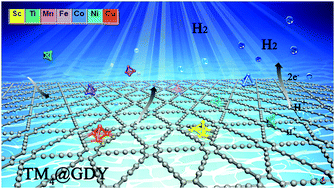Embedding tetrahedral 3d transition metal TM4 clusters into the cavity of two-dimensional graphdiyne to construct highly efficient and nonprecious electrocatalysts for hydrogen evolution reaction†
Abstract
On the basis of density functional theory (DFT) calculations, we have systematically investigated the structures and hydrogen evolution reaction (HER) catalytic activities for a series of new composite systems TM4@GDY (TM = Sc, Ti, Mn, Fe, Co, Ni and Cu), which are constructed by embedding tetrahedral 3d transition metal TM4 clusters in the in-plane cavity of two-dimensional (2D) π-conjugated graphdiyne (GDY). Our computed results reveal that compared with the constituent subunits, namely the sole TM4 cluster and GDY, all these composite TM4@GDY nanostructures can uniformly exhibit considerably high HER catalytic activity over a wide range of hydrogen coverage, and especially the Fe4@GDY and Co4@GDY systems can possess higher HER activity, in view of their higher number of active sites. The high HER catalytic activity for TM4@GDY can be mainly due to the occurrence of obvious electron transfer from TM4 cluster to GDY, significantly activating the correlative C and TM atoms. Moreover, all these composite TM4@GDY systems can also exhibit high structural stability and good conductivity. Therefore, all of them can be considered as a new kind of promising HER catalyst, and this study can provide new strategies for designing low-cost and high-performance 2D carbon-based electrocatalysts.

- This article is part of the themed collection: 2020 PCCP HOT Articles


 Please wait while we load your content...
Please wait while we load your content...